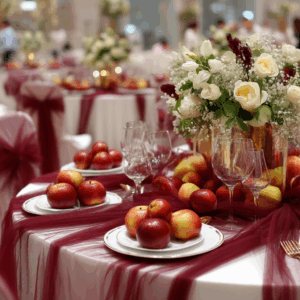Introduction
Planning a wedding dinner involves careful coordination of various elements to create a memorable and enjoyable experience for the couple and their guests. It includes selecting the menu, accommodating dietary preferences, arranging seating, and ensuring timely service. Attention to detail, budget management, and collaboration with caterers and venue staff are essential to seamlessly blend culinary delights with the celebration’s atmosphere. Effective wedding dinner planning transforms a meal into a cherished part of the wedding day.
Choosing The Perfect Menu For Your Wedding Dinner
Choosing the perfect menu for your wedding dinner is an exciting yet delicate task that sets the tone for the entire celebration. After all, food is not just nourishment; it’s an experience that brings people together, sparks conversations, and creates lasting memories. When planning your wedding dinner menu, it’s important to consider not only your personal tastes but also the preferences and dietary needs of your guests. This thoughtful approach ensures that everyone leaves the table feeling satisfied and cherished.
To begin with, envision the overall atmosphere you want to create. Are you dreaming of an elegant, formal affair with multiple courses, or a relaxed, buffet-style gathering where guests can mingle freely? The style of your wedding will naturally influence the menu choices. For a formal sit-down dinner, a carefully curated selection of appetizers, mains, and desserts can elevate the experience, while a buffet or family-style meal encourages a more casual and interactive vibe. Keeping this in mind helps narrow down the options and guides your conversations with caterers or chefs.
Next, consider the season and location of your wedding. Seasonal ingredients not only taste better but also reflect the time of year, adding a fresh and authentic touch to your menu. For example, a summer wedding might feature vibrant salads, grilled vegetables, and light seafood dishes, while a winter celebration could embrace hearty stews, roasted root vegetables, and rich desserts. Additionally, if your wedding is held outdoors or in a particular region, incorporating local flavors and specialties can make the meal feel more connected to the setting and meaningful for your guests.
As you explore menu options, it’s essential to keep dietary restrictions and preferences in mind. Nowadays, weddings often bring together a diverse group of people with varying needs, including vegetarians, vegans, gluten-free eaters, and those with allergies. Offering a variety of dishes that cater to these requirements not only shows your consideration but also ensures no one feels left out. Many caterers are adept at creating delicious alternatives that blend seamlessly with the rest of the menu, so don’t hesitate to ask for customized options.
Balancing flavors and textures is another key element in crafting a memorable wedding dinner menu. Aim for a harmonious progression of dishes that excite the palate without overwhelming it. Starting with light, refreshing appetizers can awaken the senses, followed by mains that offer a satisfying combination of protein, vegetables, and grains. Finally, a decadent dessert or a selection of sweet treats provides a perfect ending to the meal. Including a mix of familiar favorites and unique creations can delight guests and spark conversations about the food.
overwhelming it. Starting with light, refreshing appetizers can awaken the senses, followed by mains that offer a satisfying combination of protein, vegetables, and grains. Finally, a decadent dessert or a selection of sweet treats provides a perfect ending to the meal. Including a mix of familiar favorites and unique creations can delight guests and spark conversations about the food.
In addition to the food itself, think about how the menu pairs with your beverage choices. Whether you’re offering wine, cocktails, or non-alcoholic options, coordinating drinks with the courses enhances the overall dining experience. For instance, a crisp white wine might complement a seafood starter, while a robust red could accompany a rich meat dish. If you’re working with a caterer or sommelier, don’t hesitate to seek their expertise in crafting these pairings.
Finally, remember that your wedding dinner menu is a reflection of your story as a couple. Incorporating dishes that hold special meaning—perhaps a family recipe, a favorite meal from your travels, or a dish that represents your cultural heritage—adds a personal touch that resonates with both you and your guests. Sharing these stories during the meal can deepen the connection and make the dining experience even more memorable.
In essence, choosing the perfect menu for your wedding dinner is about blending practicality with creativity, tradition with innovation, and personal taste with guest enjoyment. By thoughtfully considering the style of your event, seasonal ingredients, dietary needs, flavor balance, beverage pairings, and meaningful touches, you can create a culinary journey that not only satisfies appetites but also celebrates love and togetherness in the most delicious way possible.
When it comes to planning a wedding dinner, one of the most delicate and important tasks is arranging the seating. The way guests are seated can significantly influence the atmosphere of the evening, encouraging lively conversations, fostering new friendships, and ensuring everyone feels comfortable and included. While it might seem like a simple puzzle of names and chairs, thoughtful seating arrangements require a blend of creativity, empathy, and a touch of strategy. To begin with, it’s essential to consider the relationships between your guests. Placing close family members and longtime friends near the couple often creates a warm and supportive environment. However, it’s equally important to mix in acquaintances or friends from different parts of your life to encourage mingling and prevent cliques from forming. This balance helps the dinner feel more dynamic and inclusive.
Another helpful tip is to think about the personalities of your guests. For example, pairing a few outgoing, chatty individuals with those who might be a bit shy can help break the ice and keep conversations flowing. Similarly, grouping guests with shared interests or backgrounds can spark engaging discussions and make everyone feel more at ease. If you have children attending, consider seating them together or near a designated area where they can be entertained, allowing parents to relax and enjoy the evening. Additionally, it’s wise to be mindful of any potential conflicts or sensitive dynamics. If there are guests who don’t get along or have had past disagreements, it’s best to seat them apart to avoid any uncomfortable moments. This thoughtful approach shows respect for your guests’ feelings and helps maintain a joyful atmosphere throughout the dinner.
When it comes to the layout of the tables, round tables are often favored because they encourage interaction among all guests seated there. However, long banquet-style tables can also work well, especially for larger weddings, as they create a communal feel. Whichever style you choose, placing the couple’s table in a central or slightly elevated position allows everyone to see and celebrate the newlyweds easily. It’s also a good idea to assign seats rather than leaving it open seating. While some couples prefer a more casual approach, assigned seating helps avoid confusion and ensures that your carefully planned arrangements come to life as intended. To make this process smoother, creating a clear and attractive seating chart displayed near the entrance can guide guests effortlessly to their spots.
Incorporating small personal touches at each place setting can further enhance the experience. Name cards with a little note or a fun fact about the guest can serve as conversation starters and make people feel special. Moreover, coordinating the seating with the flow of the evening’s events—such as speeches, toasts, or dances—can help keep the energy balanced and ensure that everyone has a great view of the main moments. Finally, don’t hesitate to ask for help from your wedding planner, family members, or close friends when organizing the seating. Sometimes an outside perspective can offer valuable insights or spot potential issues you might have missed. Remember, the goal is to create a welcoming and joyful environment where your guests can celebrate your special day comfortably and happily. With a little planning and a lot of heart, your wedding dinner seating arrangements will set the perfect stage for unforgettable memories.
How To Coordinate Dietary Restrictions For Wedding Guests
Planning a wedding dinner is an exciting yet intricate task, and one of the most thoughtful details to consider is how to coordinate dietary restrictions for your guests. After all, your wedding day is a celebration of love and togetherness, and ensuring everyone feels included and cared for at the dinner table is a beautiful way to honor that spirit. The first step in this process is to gather information early on. When sending out your invitations, include a polite and clear request for guests to share any dietary needs or allergies they may have. This can be done through a simple RSVP card or an online form, making it easy for guests to communicate their preferences without feeling singled out. By collecting this information well in advance, you give yourself and your caterer ample time to plan and prepare meals that accommodate everyone.
Once you have a comprehensive list of dietary restrictions, it’s important to categorize them thoughtfully. Common restrictions might include vegetarian, vegan, gluten-free, nut allergies, dairy intolerance, or religious dietary laws. Grouping these needs helps you work with your caterer to design a menu that offers variety and ensures no one feels limited in their choices. For example, a vegan guest should have options that are just as appealing and satisfying as those for meat-eaters, while someone with a nut allergy must be assured their meal is completely free of cross-contamination. Transparency is key here; when you communicate with your caterer, be explicit about the severity of allergies and the importance of avoiding cross-contact in the kitchen.
In addition to working closely with your caterer, consider how you will present these options at the wedding itself. Clear labeling on the buffet or plated meals can make a world of difference. Small cards indicating “gluten-free,” “vegan,” or “nut-free” next to each dish not only help guests navigate their choices confidently but also show that you have thoughtfully considered their needs. If you’re opting for a plated dinner, coordinating with your serving staff to deliver the correct meals to the right guests is essential. This might mean assigning a point person or informing your wedding planner to oversee the process, ensuring that no mix-ups occur during the busy dinner service.
Moreover, it’s a lovely gesture to acknowledge dietary restrictions in your wedding speech or program, expressing gratitude for your guests’ presence and your commitment to making everyone comfortable. This small touch can foster a warm and inclusive atmosphere, reminding everyone that your celebration is about connection and care. Remember, flexibility is also important. Sometimes, despite best efforts, last-minute changes or undisclosed allergies may arise. Having a few backup options or snacks on hand can save the day and ease any unexpected challenges.
Ultimately, coordinating dietary restrictions for wedding guests is an act of kindness that reflects your attentiveness as a host. By gathering information early, collaborating closely with your caterer, clearly labeling food, and maintaining open communication, you create a dining experience where every guest feels valued and included. This thoughtful approach not only enhances the enjoyment of your wedding dinner but also leaves a lasting impression of warmth and consideration, making your special day even more memorable for everyone involved.
Conclusion
Effective wedding dinner planning ensures a seamless and memorable experience by carefully considering guest preferences, dietary restrictions, budget, and timing. Thoughtful menu selection, coordination with caterers, and attention to detail contribute to a joyful celebration that complements the overall wedding atmosphere.
